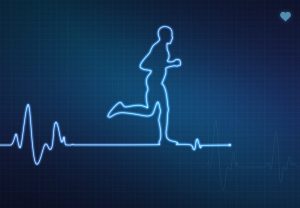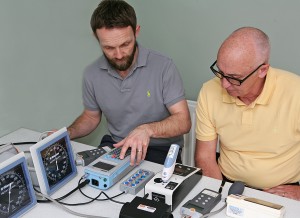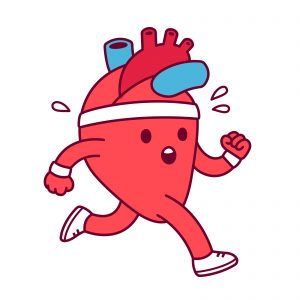Medical Equipment Calibration | There are a number of different measures to fight against the “silent killer” that is Hypertension (otherwise known as high blood pressure). Among them is ensuring regular physical activity in your everyday life. In this article, you will find information and practical tips on physical activity that is suitable for individuals with hypertension. Thus, allowing you to benefit from all the positive aspects of sport and exercise on your health.
The Benefits of Sports Activity
Prof. Xavier Girerd of the Committee for the Fight against Hypertension (CFLHTA) stressed that the scientific evidence shows that:
- In early hypertension, improvements in diet and undertaking physical or sports activity are measures that delay the requirement of treatment for hypertension with drugs;
- Physical activity of moderate but regular intensity, 2-4 times per week, is more effective at lowering blood pressure than vigorous exercise once a week;
- The beneficial effects on reducing blood pressure do not always depend on weight loss, but physical activity helps maintain weight loss;
- Physical activity contributes to control diabetes, reduces the risk of osteoporosis and helps maintain bone, muscle, and joint functions.
What Is Your Favourite Activity?
Not all types of physical activity have the same benefits for the health of an individual who has hypertension. It is preferable to undertake endurance exercises with moderate but prolonged intensity: fast walking, cycling, swimming, jogging. The goal is to spend 2,000 Kcalories, which corresponds to 60 minutes of light activities or 20 to 30 Minutes of intense activity.
| Light intensity 60 minutes | Average intensity 30 to 45 minutes | High Intensity 20 to 30 minutes |
| – Walk without hurry;
– Perform light gardening or housework; – Do stretching exercises. |
– A good walk;
– Take a bike ride; – Gardening work that requires effort; – Swim or dance without straining; – Gymnastics at home; – Play tennis |
– Gymnastics in a gym;
– Jogging; – Swim or dance at a steady pace; – Cycling on and exercise bike. |

If you want to play a ball sport, such as football, basketball etc.. it is beneficial if this activity is undertaken to a similar degree of endurance and that the teammates are of the same fitness level. Finally, the sport must remain a pleasure and a moment of relaxation, so choose an activity(s) wisely.
But to reach the 2,000 Kcalories, it is possible to adapt physical activities by referring to the table of the CFLHTA below:
| Activity | Weight 50 kg | Weight 70 kg | Weight 80 kg | Weight 90 kg |
| Climbing the stairs four floors | 13 | 19 | 22 | 24 |
| Walk the dog 15 minutes | 44 | 60 | 69 | 78 |
| Gymnastics at home 15 minutes | 75 | 105 | 120 | 135 |
| Wash the floor 30 minutes | 82 | 115 | 132 | 148 |
| Gardening 60 minutes | 215 | 301 | 344 | 387 |
| Walk a good walk 60 minutes | 233 | 320 | 369 | 416 |
| Swimming 30 minutes | 300 | 420 | 480 | 540 |
| Jogging 45 minutes | 375 | 525 | 600 | 675 |
| Tennis Match | 400 | 420 | 640 | 720 |
| Bicycle tour 60 minutes | 500 | 700 | 800 | 900 |
| Golf 120 minutes | 500 | 700 | 800 | 900 |
What are your limits?
Depending on your training, your age and your lifestyle, certain limits must be respected. The CFLHTA recommends two methods:
- Regular Pulse Measurement – which corresponds to the measurement of cardiac activity. During exercise, a heart rate monitor gives reliable measurements. It is advisable not to exceed an exercise frequency equal to 80% of the formula 220 – age.
Example at 60 years: 220 – 60 = 160 x 80% = 128 beats per minute.
A recent US publication even plans to revise this formula by applying the following formula: 208 – (0.7 x age).
Example: at age 60, 208 – (0.7 x 60) = 166. - Shortness of breath is a good reflection of our limits. It is recommended to slow down and even stop when you are no longer able to speak during an effort.
In all hypertensive individuals, it is important to breathe freely during exercise, to avoid short and violent exertion, to respect the three phases of a physical exercise session (warm-up, exercise period, recovery) and not to exceed its limits.

Finally, it is not advisable to go full-throttle in a sporting activity or start a new fitness regime without understanding the health risks. Therefore, talk to your doctor about your intention to resume physical activity and the measures to fight against hypertension; as they will be able to help you choose the most suitable for your condition and adjust if necessary your hypertensive treatment.
Self-measurement to better treat hypertension
-
- Ask your doctor or pharmacist for advice on how to buy a registered self-test device and how to use it properly.
- Use a blood pressure monitor with a reliable arm cuff.
- Use your device in a sitting position, in the morning before breakfast then in the evening between dinner and bedtime, by performing a series of three consecutive measurements over a few minutes.
- Carry out your self-report for 3 days, a few days before your medical consultation.
- Show your doctor your self-report, this will help them better treat your hypertension.

Forest Medical Equipment Calibration
As we specialise in Medical Equipment Calibration Services, we can provide all the help you need to keep your home blood pressure monitor in good condition and working at its very best, ensuring that you can continue to receive accurate results and stay well informed about your health. Whether your monitor requires a repair or you simply wish to make sure it is in full working order and giving you accurate readings, we can provide the help you need.
Our service is fast and convenient for you, so you are not left without your vital medical equipment for long periods of time. We aim to complete the calibration and checking of your equipment within 24 hours, and if required, we can repair it free of charge. If you have any concerns about your home testing equipment, send it to us and let us help you keep an eye on your heart health with our medical calibration services and testing.


